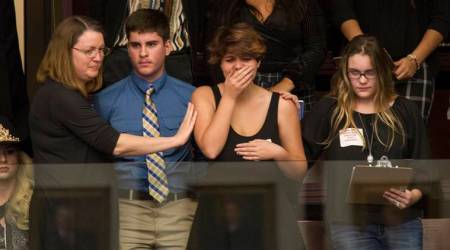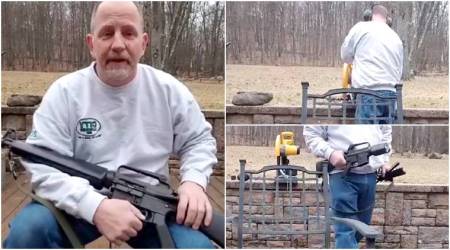 Below the video, YouTube’s algorithm suggested viewers watch a clip with similar claims. (File Photo)
Below the video, YouTube’s algorithm suggested viewers watch a clip with similar claims. (File Photo)
YouTube was criticized after promoting a video with a title that suggested a teenage survivor of last week’s Florida school shooting was a paid actor, the latest sign of the internet industry’s ongoing struggle to suppress conspiracy theories, fake news and bots.
The video shows David Hogg, a student who has spoken out for gun control after the attack that killed 17 in Parkland, Florida, in a Los Angeles TV news clip from last summer. A description of the video read, ‘DAVID HOGG THE ACTOR….’. Below the video, YouTube’s algorithm suggested viewers watch a clip with similar claims. The first video spent several hours at the top of YouTube’s ‘Trending’ section before being removed on Wednesday. “This video should never have appeared in Trending. Because the video contained footage from an authoritative news source, our system misclassified it,” a spokeswoman for Google’s YouTube wrote in an emailed statement. “As soon as we became aware of the video, we removed it from Trending and from YouTube for violating our policies.”
Alphabet Inc’s Google has implemented a number of policy changes aimed at stamping out misinformation and fake content in its search results and other online properties. It pledged to have more than 10,000 human beings across Google working to address problematic content issues in 2018. YouTube also introduced measures to move more verified news sources to the top of search results. Wednesday’s trending video of Hogg was footage from a CBS TV news affiliate, although the video wasn’t uploaded by a verified news channel. “We’ve seen improvements, but in some circumstances these changes are not working quickly enough,” YouTube said in a later statement. “In addition, last year we updated the application of our harassment policy to include hoax videos that target the victims of these tragedies.”
After the clip was removed on Wednesday morning, a search for ‘David Hogg’ still generated several videos claiming the Florida teenager is an actor. “When conspiracy theories like the David Hogg ‘crisis actor’ video start trending, most people think, ‘This is bad information and should be removed,’” Mathew Ingram, a writer at Columbia Journalism Review, said on Twitter. “But YouTube’s algorithm seems to think, ‘Hey, lots of people seem to like conspiracy theories, so we should show them more.’”
YouTube’s struggle to quash misleading videos and gaming of its algorithms drew renewed criticism from both users of its service and outside observers. The problems may also fuel more calls for regulation of social media. YouTube, Twitter Inc and Facebook Inc have been hauled in front of Congress to explain why their services were used by Russian actors and bots to spread fake, misleading and divisive messages and buy controversial ads around the 2016 presidential election. There’s already a bill proposing more disclosure of online political ads, and UK lawmakers traveled to Washington earlier this month to press the industry to do more. They suggested the problems stem from lack of regulation and advertising-dependent business models that reward click-bait and inflammatory material.
All three companies are changing their approaches to try to spot and remove fake and misleading content and delete some automated accounts. But problems keep bubbling up. On Wednesday, Twitter was criticized by conservative users who complained that the company’s effort to stamp out bots was unfairly targeting their followers. One concern is that the artificial intelligence technology these companies are using to help them identify misleading content is also being used to create even more sophisticated lies and propaganda online. AI research groups, including OpenAI, this month released a study showing how this technology is being used to create fake news with realistic fabricated videos and audio – including clips of state leaders seeming to make inflammatory comments.
 YouTube, Twitter Inc and Facebook Inc have been hauled in front of Congress to explain why their services were used by Russian actors and bots to spread fake, misleading and divisive messages and buy controversial ads around the 2016 presidential election. (File Photo)
YouTube, Twitter Inc and Facebook Inc have been hauled in front of Congress to explain why their services were used by Russian actors and bots to spread fake, misleading and divisive messages and buy controversial ads around the 2016 presidential election. (File Photo)
“’Fake News’ may only be the beginning,” Senator Mark Warner, Democrat of Virginia, wrote in a tweet Tuesday. “We need to start thinking about the consequences of fake video technology and how we maintain trust in a digital-based economy when you may not be able to believe your own eyes anymore.”
For all the latest Technology News, download Indian Express App
























